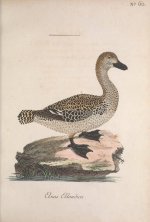Björn Bergenholtz
(former alias "Calalp")

As far as I understand it the invalid name "Anas Sparrmanni" (sic) LATHAM 1790 (later, also by, Latham called "Sparrman's Duck") was apparently based on the equally invalid “Anas alandica” SPARRMAN 1788, shot (by a Dr. Lindroth) in the Finnish (at that time Swedish) archipelago of Åland in the Baltic Sea (thereby "alandica") … but the question is:
Isn't that (see attached Plate) simply a female specimen of (Common/Northern) Pintail Anas a. acuta LINNAEUS 1758 … !?
If so presumably a young specimen (darker bill and more contrasting head/neck-pattern). Compare with, for example; this photo or this one (even if the age of those certain Ducks isn´t mentioned).
Anyone with extensive experience of young female Pintails disagree?
PS. Link to full volume of Sparrman's Museum Carlsonianum III (here)
Isn't that (see attached Plate) simply a female specimen of (Common/Northern) Pintail Anas a. acuta LINNAEUS 1758 … !?
If so presumably a young specimen (darker bill and more contrasting head/neck-pattern). Compare with, for example; this photo or this one (even if the age of those certain Ducks isn´t mentioned).
Anyone with extensive experience of young female Pintails disagree?
PS. Link to full volume of Sparrman's Museum Carlsonianum III (here)




